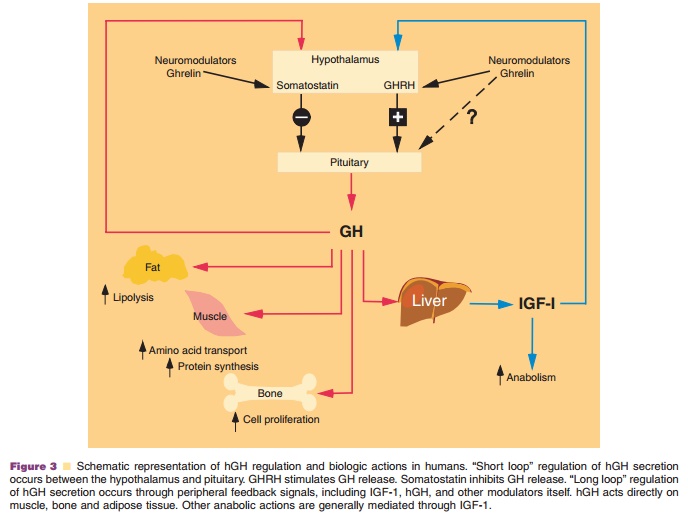Chapter: Pharmaceutical Biotechnology: Fundamentals and Applications : Growth Hormones
Growth Hormone Secretion and Regulation
PHARMACOLOGY
Growth Hormone Secretion and Regulation
Growth hormone is secreted from somatotrophs in the anterior pituitary. Multiple feedback loops are present in normal regulation of hGH secretion (Casanueva, 1992; Giustina and Veldhuis 1998) (Fig. 3). Growth hormone release from the pituitary is regulated by a “short loop” of two coupled hypothalamic peptides—a stimulatory peptide,

growth hormone releasing hormone (GHRH) and an inhibitory peptide,
somatostatin. GHRH and somatostatin are, in turn, regulated by neuronal input
to the hypothalamus and the GH secretagogue, ghrelin (Kojima et al., 2001).
There is possibly also an “ultrashort loop” in which hGH release is feedback
regulated by growth hormone receptors present on the somatotrophs of the
pituitary them-selves. Growth hormone secretion is also regulated by a “long
loop” of peripheral signals including insulin-like growth factor (IGF-1) and
other modulators.
Growth hormone secretion changes during human development, with the
highest production rates observed during gestation and puberty (Brook and
Hindmarsh 1992; Guistina and Veldhuis, 1998). Growth hormone production
de-clines approximately 10 to 15% each decade from age 20 to 70 years.
Endogenous hGH secretion also varies with sex, nutritional status, obesity,
physical activity, and in a variety of disease states. Endogenous hGH is
secreted in periodic bursts over a 24 hour period with great variability in
burst frequency, amplitude and duration. There is little detectable hGH
released from the pituitary between bursts. The highest endogenous hGH serum
con-centrations of 10 to 30 ng/mL usually occur at night when the secretory
bursts are largest and most frequent.
Related Topics